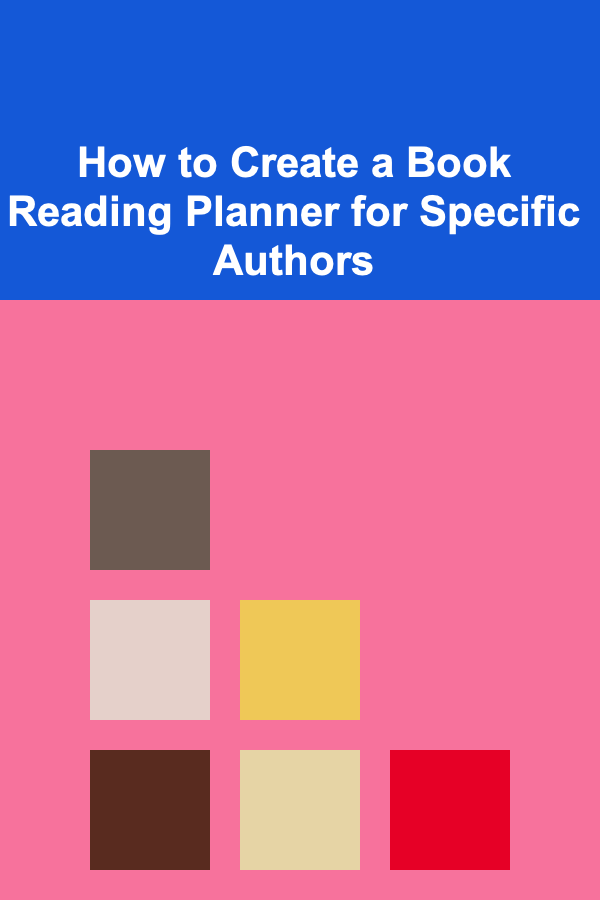
How to Create a Book Reading Planner for Specific Authors
ebook include PDF & Audio bundle (Micro Guide)
$12.99$5.99
Limited Time Offer! Order within the next:

Reading is a fulfilling journey, and organizing that journey can enhance your experience, especially when focusing on specific authors. Whether you're a fan of a particular genre or have an admiration for a certain writer, a book reading planner can be an invaluable tool to help you systematically explore their works. In this article, we'll walk through how to create a book reading planner for specific authors, helping you immerse yourself in their literature, track your progress, and gain deeper insights into their style and themes.
Why Create a Book Reading Planner for Specific Authors?
A book reading planner for specific authors serves several purposes that enrich your reading experience. These benefits include:
- Structured Exploration: Organizing your reading schedule helps you approach an author's works in a systematic and methodical way, ensuring you don't miss any essential books.
- Chronological Understanding: Many authors evolve over time, and reading their works in the order they were written can help you understand their development and literary progression.
- Thematic Connections: Reading multiple books by the same author allows you to spot recurring themes, stylistic elements, and character development, offering a richer, more cohesive experience.
- Deep Dive into an Author's World: By reading only one author or a small group of authors, you can immerse yourself in their unique perspective and gain a comprehensive understanding of their worldview.
In essence, a reading planner can turn the act of reading into an intentional, thoughtful journey, whether you're reading for pleasure, research, or personal development.
Steps to Create a Book Reading Planner for Specific Authors
The key to a successful reading planner lies in structuring your plan in a way that aligns with your goals and preferences. Below are the essential steps to create a personalized book reading planner.
Step 1: Choose the Author(s) You Want to Focus On
The first step in creating a book reading planner is choosing the author or authors you'd like to focus on. Whether you have one author in mind or a list of authors whose works you want to explore, it's important to make a clear decision before diving into the details.
Consider the following when selecting an author:
- Your Interests: Choose an author whose works resonate with your tastes or interests. This will ensure that your reading journey is enjoyable and engaging.
- Author's Range of Works: Consider authors with a wide variety of books, including novels, short stories, essays, or poetry. A diverse body of work gives you more to explore.
- Literary Reputation: Some authors have a distinct literary significance, and their works may offer more than just entertainment---they can provide valuable insights into the human experience, society, or history.
For instance, if you're interested in dystopian fiction, authors like George Orwell, Aldous Huxley, or Margaret Atwood may be great candidates. On the other hand, if you want to explore modern American literature, authors like Don DeLillo, Toni Morrison, or Cormac McCarthy could be your focus.
Step 2: Research the Author's Complete Works
Once you've chosen the author, the next step is to research and compile a list of their complete works. Many authors have a large body of work spanning several decades, and understanding their output can help you decide where to start and how to structure your reading plan.
Start by identifying the following:
- Novels: Most authors have key novels that define their careers. These are often the most well-known works and may be a good starting point.
- Short Stories and Essays: Short stories and essays can offer insights into an author's style and themes in a more concentrated form.
- Posthumous Works: Some authors have posthumously published works, which could add an additional layer of interest to your reading plan.
- Chronological or Thematic Grouping: Depending on the author's work, you might group books by chronology (the order in which they were published) or by themes (e.g., social issues, existentialism, political philosophy).
Step 3: Set Goals for Your Reading
After gathering the necessary information about your chosen author's works, you should set clear goals for your reading. These goals will keep you motivated and provide direction throughout the reading process.
Consider the following types of goals:
- Number of Books to Read: Decide on how many books by the author you would like to read in a given period---say, one book per month, or one per week, depending on your reading speed and schedule.
- Depth of Study: Do you simply want to enjoy the books or gain a deeper understanding? Setting a goal to read analytically (i.e., noting themes, character development, and writing style) can enrich your experience.
- Explore Certain Genres: Many authors write across different genres. You can set a goal to read one genre at a time (e.g., focusing on their detective stories first, then their romance novels).
- Contextual Goals: You may want to learn about the historical, cultural, or philosophical context behind the author's works. In this case, your reading plan might include books from the author's influences or critical essays on their work.
Step 4: Organize the Books into a Reading Timeline
With your goals in mind, organize the books into a reading timeline. This timeline will ensure that you're following a systematic approach, either by reading the books in order of publication or by focusing on thematic or genre-based blocks of reading.
Consider the following approaches to structuring your reading timeline:
- Chronological Order: If you're interested in understanding how the author's style evolves over time, reading their works in the order they were published might be the best approach.
- By Themes: If your goal is to explore particular themes or ideas in the author's works, organizing the books by thematic clusters can be an insightful way to proceed. For example, you might read books that address political themes before moving on to those that focus on love or existentialism.
- By Genre: If the author's body of work spans multiple genres (e.g., science fiction, literary fiction, plays), you can create a genre-based reading timeline to experience each genre more thoroughly.
Once you've selected your approach, break your reading into smaller chunks, like months or weeks, based on the number of books you've selected and your reading speed.
Step 5: Create a Reading Schedule
Now that you have your books and timeline in place, it's time to create a reading schedule. Be realistic about how much time you can dedicate to reading on a daily or weekly basis.
Consider these tips when creating your reading schedule:
- Time Commitment: Estimate how long each book will take you to read. This varies based on the length of the book and your reading pace.
- Daily/Weekly Targets: Break your reading into manageable chunks. For example, you might aim to read 20 pages per day or one chapter per day, depending on the book's length and complexity.
- Flexibility: Life can get busy, so allow flexibility in your schedule. Don't be too hard on yourself if you fall behind, and give yourself permission to adjust your timeline as needed.
Step 6: Track Your Progress and Adjust
A key part of maintaining a book reading planner is tracking your progress. Use a reading log, spreadsheet, or app to record your reading progress. This allows you to stay motivated and keep track of what you've already read.
Here are some ways to track your reading:
- Reading Journal: Write notes about each book as you finish it. This can help you reflect on the themes, character arcs, and personal takeaways.
- Books Read List: Keep a simple list of books read and your personal rating or review of them.
- Apps or Websites: Use websites like Goodreads to track your progress, set goals, and join reading challenges.
As you read through the books, don't be afraid to adjust your plan if needed. You may discover new aspects of the author's work that you want to explore further or encounter books that you feel compelled to prioritize.
Step 7: Engage with the Author's Community and Critics
In addition to reading the books, consider engaging with other readers and critics who are familiar with the author. This can help you deepen your understanding and gain new perspectives.
- Join Online Forums and Book Clubs: Many authors have fan communities where readers discuss their works. Engaging with others can provide fresh insights and interpretations.
- Read Critical Essays and Biographies: To better understand the author's life and influences, read essays and biographies that provide context for their work.
- Attend Author Events or Lectures: If possible, attend events where the author is discussed or where experts analyze their work.
Engagement with the author's broader literary world enhances your reading experience and provides a well-rounded understanding of their contributions to literature.
Conclusion
Creating a book reading planner for specific authors is an enriching way to immerse yourself in the works of a single writer and gain a deeper understanding of their literary universe. By following the steps outlined in this guide---choosing the right author, setting clear goals, creating a structured timeline, and engaging with the broader literary context---you can turn your reading into an intentional, rewarding experience.
With a well-thought-out plan, you'll not only read more books by your chosen author but also gain insights into their evolution, themes, and literary contributions. Whether you're a fan of classic literature, contemporary fiction, or niche genres, this approach can elevate your reading experience and help you fully appreciate the depth of your favorite author's works.
Reading More From Our Other Websites
- [Home Pet Care 101] How to Manage Pet Allergies in Your Home
- [Tiny Home Living Tip 101] Best Low‑Maintenance Landscaping Ideas for Tiny Home Communities
- [Personal Investment 101] How to Monetize Your Deep Learning Projects for Recurring Revenue
- [Organization Tip 101] How to Maintain and Protect Your Concrete Stained Floors for Years to Come
- [Home Budget Decorating 101] How to Practice Frugal Home Styling by Utilizing What You Already Have and Smart Shopping Strategies
- [Home Budget Decorating 101] How to Create a Chic Dining Room on a Tight Budget
- [Personal Investment 101] How to Build a Real Estate Investment Trust (REIT) Portfolio
- [Hiking with Kids Tip 101] From Trembling to Trail-Ready: Practical Tips for Managing Kids' Fear of Heights
- [Biking 101] How to Choose the Best Cyclocross Bike for Tough Terrain
- [Personal Investment 101] Monetizing Deep Learning: How to Make Money from AI Models

How to Care for Your Pet's Ears and Eyes
Read More
How to Create a Financial Plan for a Single Parent Household
Read More
How to Start Saving Money on Household Bills: Easy and Effective Strategies
Read More
How to Tidy Up Your Home with Simple Daily Habits
Read More
How to Use Leftover Ingredients Creatively in Meal Prep
Read More
Attracting Woodpeckers to Your Yard: A Comprehensive Guide
Read MoreOther Products

How to Care for Your Pet's Ears and Eyes
Read More
How to Create a Financial Plan for a Single Parent Household
Read More
How to Start Saving Money on Household Bills: Easy and Effective Strategies
Read More
How to Tidy Up Your Home with Simple Daily Habits
Read More
How to Use Leftover Ingredients Creatively in Meal Prep
Read More